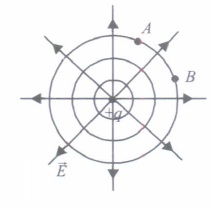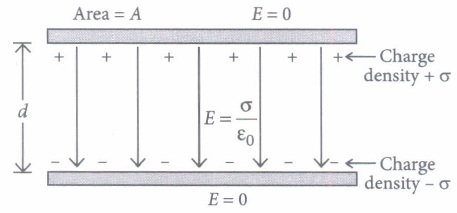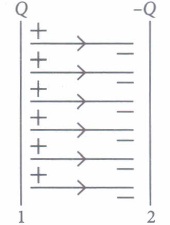CBSE 12th Standard Physics Subject Electrostatic Potential And Capacitance Chapter Case Study Questions With Solution 2021
By QB365 on 21 May, 2021
QB365 Provides the updated CASE Study Questions for Class 12 , and also provide the detail solution for each and every case study questions . Case study questions are latest updated question pattern from NCERT, QB365 will helps to get more marks in Exams
QB365 - Question Bank Software
CBSE 12th Standard Physics Subject Electrostatic Potential And Capacitance Case Study Questions With Solution 2021
12th Standard CBSE
-
Reg.No. :
Physics
-
For the various charge systems, we represent equipotential surfaces by curves and line of force by full line curves. Between any two adjacent equipotential surfaces, we assume a constant potential difference the equipotential surfaces of a single point charge are concentric spherical shells with their centres at the point charge. As the lines of force point radially outwards, so they are perpendicular to the equipotential surfaces at all points.

(i) Identify the wrong statement.(a) Equipotential surface due to a single point charge is spherical. (b) Equipotential surface can be constructed for dipoles too. (c) The electric field is normal to the equipotential surface through the point. (d) The work done to move a test charge on the equipotential surface is positive (ii) Nature of equipotential surface for a point charge is
(a) Ellipsoid with charge at foci (b) Sphere with charge at the centre of the sphere (c) Sphere with charge on the surface of the sphere (d) Plane with charge on the surface (iii) A spherical equipotential surface is not possible
(a) inside a uniformly charged sphere (b) for a dipole (c) inside a spherical condenser (d) for a point charge (iv) The work done in carrying a charge q once round a circle of radius a with a charge Q at its centre is
\(\text { (a) } \frac{q Q}{4 \pi \varepsilon_{0} a}\) \(\text { (b) } \frac{q Q}{4 \pi \varepsilon_{0} a^{2}}\) \(\text { (c) } \frac{q}{4 \pi \varepsilon_{0} a}\)
(d) zero
(v) The work done to move a unit charge along an equipotential surface from P to Q
(a) must be defined as \(-\int_{P}^{Q} \vec{E} \cdot d \vec{l}\) (b) is zero (c) can have a non-zero value (d) both (a) and (b) are correct (a) -
This energy possessed by a system of charges by virtue of their positions. When two like charges lie infinite distance apart, their potential energy is zero because no work has to be done in moving one charge at infinite distance from the other.
In carrying a charge q from point A to point B, work done \(W=q\left(V_{A}-V_{B}\right)\). This work may appear as change in KE/PE of the charge. The potential energy of two charges q1 and q2 at a distance r in air is \(\frac{q_{1} q_{2}}{4 \pi \varepsilon_{0} r}\). It is measured in joule. It may be positive, negative or zero depending on the signs of ql and q2.
(i) Calculate work done in separating two electrons form a distance of 1m to 2m in air, where e is electric charge and k is electrostatic force constant.(a) ke2 (b) e2/2 (c) -ke2/2 (d) zero (ii) Four equal charges q each are placed at four corners of a square of side a each. Work done in carrying a charge -q from its centre to infinity is
(a) zero \(\text { (b) } \frac{\sqrt{2} q^{2}}{\pi \varepsilon_{0} a}\) \(\text { (c) } \frac{\sqrt{2} q}{\pi \varepsilon_{0} a}\) \(\text { (d) } \frac{q^{2}}{\pi \varepsilon_{0} a}\) (iii) Two points A and B are located in diametrically opposite directions of a point charge of +2 \(\mu \mathrm{C}\) at distances 2 m and 1 m respectively from it. The potential difference between A and B is
(a) 3 x 103 V (b) 6 x 104 V (c) -9 X 103 V (d) -3 x 103 V (iv) Two point charges A = +3 nC and B = +1 nC are placed 5 ern apart in air. The work done to move charge B towards A by 1 cm is
(a) 2.0 x 10-7 J (b) 1.35 x 10-7 J (c) 2.7 X 10-7 J (d) 12.1 x 10-7 J (v) A charge Q is placed at the origin. The electric potential due to this charge at a given point in space is V. The work done by an external force in bringing another charge q from infinity up to the point is
\(\text { (a) } \frac{V}{q}\) (b) Vq (c) V + q (d) V (a) -
The simplest and the most widely used capacitor is the parallel plate capacitor. It consists of two large plane parallel conducting plates, separated by a small distance.
In the outer regions above the upper plate and below the lower plate, the electric fields due to the two charged plates cancel out. The net field is zero.
In the inner region between the two capacitor plates, the electric fields due to the two charged plates add up. The net field is \(\frac{\sigma}{\varepsilon_{0}}\).

For a uniform electric field, potential difference between the plates = Electric field x distance between the plates. Capacitance of the parallel plate capacitor is, the charge required to supplied to either of the conductors of the capacitor so as to increase the potential difference between then by unit amount.
(i) A parallel plate capacitor is charged and then isolated. The effect of increasing the plate separation on charge, potential and capacitance respectively are(a) increases, decreases, decreases (b) constant, increases, decreases (c) constant, decreases, decreases (d) constant, decreases, increases (ii) In a parallel plate capacitor, the capacity increases if
(a) area of the plate is decreases (b) distance between the plates increases (c) area of the plate is increases (d) dielectric constant decreases (iii) A parallel plate capacitor has two square plates with equal and opposite charges. The surface charge densities on the plates are \(+\sigma\) and \(-\sigma\) respectively. In the region between the plates the magnitude of the electric field is
\(\text { (a) } \frac{\sigma}{2 \varepsilon_{0}}\) \(\text { (b) } \frac{\sigma}{\varepsilon_{0}}\) (c) 0 (d) none of these. (iv) If a parallel plate air capacitor consists of two circular plates of diameter 8 cm. At what distance should the plates be held so as to have the same capacitance as that of sphere of diameter 20 cm?
(a) 9mm (b) 4mm (c) 8mm (d) 2mm (v) If a charge of + 2.0 x 10-8 C is placed on the positive plate and a charge of -1.0 x 10-8 C on the negative plate of a parallel plate capacitor of capacitance 1.2 x 10-3 \(\mu \mathrm{F}\) then the potential difference developed between the plates is
(a) 6.25 V (b) 3.0 V (c) 12.5 V (d) 25 V (a) -
A dielectric slab is a substance which does not allow the flow of charges through it but permits them to exert electrostatic forces on one another.
When a dielectric slab is placed between the plates, the field Eo polarises the dielectric. This induces charge -Qp on the upper surface and + Qp on the lower surface of the dielectric. These induced charges set up a field Ep inside the dielectric in the opposite direction of \(\vec{E}_{0}\) as shown.

(I) In a parallel plate capacitor, the capacitance increases from \(4 \mu \mathrm{F}\) to 80\(\mu \mathrm{F}\) on introducing a dielectric medium between the plates. What is the dielectric constant of the medium?(a) 10 (b) 20 (c) 50 (d) 100 (ii) A parallel plate capacitor with air between the plates has a capacitance of 8 pF. The separation between the plates is now reduced half and the space between them is filled with a medium of dielectric constant 5.
Calculate the value of capacitance of the capacitor in second case.(a) 8pF (b) 10pF (c) 80pF (d) 100pF (iii) A dielectric introduced between the plates of a parallel plate condenser
(a) decreases the electric field between the plates (b) increases the capacity of the condenser (c) increases the charge stored in the condenser (d) increases the capacity of the condenser (iv) A parallel plate capacitor of capacitance 1 pF has separation between the plates is d. When the distance of separation becomes 2d and wax of dielectric constant x is inserted in it the capacitance becomes 2 pF. What is the value of x?
(a) 2 (b) 4 (c) 6 (d) 8 (v) A parallel plate capacitor having area A and separated by distance d is filled by copper plate of thickness b. The new capacity is
\(\text { (a) } \frac{\varepsilon_{0} A}{d+\frac{b}{2}}\) \(\text { (b) } \frac{\varepsilon_{0} A}{2 d}\) \(\text { (c) } \frac{\varepsilon_{0} A}{d-b}\) \(\text { (d) } \frac{2 \varepsilon_{0} A}{d+\frac{b}{2}}\) (a) -
A capacitor is a device to store energy. The process of charging up a capacitor involves the transferring of electric charges from its one place to another. This work done in charging the capacitor is stored as its electrical potential energy.

If q is the charge and V is the potential difference across a capacitor at any instant during its charging, then small work done in storing an additional small charge dq against the repulsion of charge q already stored on it is \(d W=V . d q=(q / C) d q\)
(i) A system of 2 capacitors of capacitance \(2 \mu \mathrm{F}\) and \(4 \mu \mathrm{F}\) is connected in series across a potential difference of 6 V. The energy stored in the system is\(\text { (a) } 3 \mu \mathrm{J}\) \(\text { (b) } 24 \mu \mathrm{J}\) \(\text { (c) } 30 \mu \mathrm{J}\) \(\text { (d) } 108 \mu \mathrm{J}\) (ii) A capacitor of capacitance of \(10 \mu \mathrm{F}\) is charged to 10 V. The energy stored in it is
\(\text { (a) } 100 \mu \mathrm{J}\) \(\text { (b) } 500 \mu \mathrm{J}\) \(\text { (c) } 1000 \mu \mathrm{J}\) \(\text { (d) } 1 \mu \mathrm{J}\) (iii) A parallel plate air capacitor has capacity C farad, potential V volt and energy E joule. When the gap between the plates is completely filled with dielectric
(a) both V and E increase (b) both V and E decrease (c) V decreases, E increases (d) V increases, E decreases (iv) A capacitor with capacitance \(5 \mu \mathrm{F}\) is charged to \(5 \mu \mathrm{C}\). If the plates are pulled apart to reduce the capacitance to \(2 \mu \mathrm{F}\),how much work is done?
\(\text { (a) } 6.25 \times 10^{-6} \mathrm{~J}\) \(\text { (b) } 3.75 \times 10^{-6} \mathrm{~J}\) \(\text { (c) } 2.16 \times 10^{-6} \mathrm{~J}\) \(\text { (d) } 2.55 \times 10^{-6} \mathrm{~J}\) (v) A metallic sphere of radius 18 cm has been given a charge of 5 x 10-6 C. The energy of the charged conductor is
(a) 0.2 J (b) 0.6 J (c) 1.2 J (d) 2.4 J (a)
Part A
*****************************************
CBSE 12th Standard Physics Subject Electrostatic Potential And Capacitance Case Study Questions With Solution 2021 Answer Keys
-
(i) (d)
(ii) (b)
(iii) (b)
(iv) (d): The electrical potential at any (J) point on circle of radius a due to charge Qa Q.at Its centre I.S V = \(V=\frac{1}{4 \pi \varepsilon_{0}} \frac{Q}{a}\)
It is an equipotential surface.
Hence, work done in carrying a charge q round the circle is zero.

(v) (d): Work done to move a unit charge along an equipotential surface from P to Q,
\(W=-\int_{P}^{Q} \vec{E} \cdot d \vec{l}\)
On equipotential surface \(\vec{E} \perp d \vec{l}\)
\(W=-\int_{P}^{Q} E(d l) \cos 90^{\circ}=0\) -
(i) (c): \(W=(\text { P.E. })_{\text {final }}-(\text { P.E. })_{\text {initial }}\)
\(=\frac{k e^{2}}{2}-\frac{k e^{2}}{1}=\frac{-k e^{2}}{2}\)
(ii) (b) : Potential at the centre of the square due to four equal charges q at four corners
\(V=\frac{4 q}{4 \pi \varepsilon_{0}(a \sqrt{2}) / 2}=\frac{\sqrt{2} q}{\pi \varepsilon_{0} a}\)
\(W_{0 \rightarrow \infty}=-W_{\infty \rightarrow 0}=-(-q) V=\frac{\sqrt{2} q^{2}}{\pi \varepsilon_{0} a}\)
(iii) (c): Here, \(q=2 \mu \mathrm{C}=2 \times 10^{-6} \mathrm{C}, r_{A}=2 \mathrm{~m}, r_{B}=1 \mathrm{~m}\)
\(\therefore \ V_{A}-V_{B}=\frac{q}{4 \pi \varepsilon_{0}}\left[\frac{1}{r_{A}}-\frac{1}{r_{B}}\right]\)
\(=2 \times 10^{-6} \times 9 \times 10^{9}\left[\frac{1}{2}-\frac{1}{1}\right] \mathrm{V}=-9 \times 10^{3} \mathrm{~V}\)
(iv)(b) : Required work done = Change in potential energy of the system
\(W=U_{f}-U_{i}=k \frac{q_{1} q_{2}}{r_{f}}-k \frac{q_{1} q_{2}}{r_{i}}=k q_{1} q_{2}\left[\frac{1}{r_{f}}-\frac{1}{r_{i}}\right]\)
\(\therefore \ W=\left(9 \times 10^{9}\right)\left(3 \times 10^{-9} \times 1 \times 10^{-9}\right)\) \(\times\left[\frac{1}{4 \times 10^{-2}}-\frac{1}{5 \times 10^{-2}}\right]\)
\(=27 \times 10^{-7} \times(0.05)=1.35 \times 10^{-7} \mathrm{~J}\)
(v) (b) -
(i) (b): As the capacitor is isolated after charging, charge Q on it remains constant: Plate separation d Increases, capaci.tance decreases as \(C=\frac{\varepsilon_{0} A}{d}\) and hence, potential increases as \(V=\frac{Q}{C}\).
(ii) (c): In a parallel plate capacitor, the capacity of capacitor
\(C=\frac{K \varepsilon_{Q} A}{d} \quad \text { i.e., } C \propto A\)
The capacity of capacitor increases if area of the plate increases.
(iii) (b): The magnitude of the electric field between the plates is E = \(\frac{\sigma}{2 \varepsilon_{0}}-\left(-\frac{\sigma}{2 \varepsilon_{0}}\right)=\frac{\sigma}{\varepsilon_{0}}\)
(IV) (b): As \(\frac{\varepsilon_{0} A}{d}=4 \pi \varepsilon_{0} R \text { or } \frac{\varepsilon_{0} \pi D^{2}}{4 d}=4 \pi \varepsilon_{0} R\)
\(\text { or } \quad d=\frac{D^{2}}{16 R}=\frac{(0.08)^{2}}{16 \times 0.10}=4 \times 10^{-3} \mathrm{~m}=4 \mathrm{~mm}\)
(v) (c): Here \(V=\frac{q_{1}-q_{2}}{2 C}\)
\(=\frac{2.0 \times 10^{-8}+1.0 \times 10^{-8}}{2 \times 1.2 \times 10^{-9}}=12.5 \mathrm{~V}\) -
(i) (b): \(k=\frac{\text { Capacitance with dielectric }}{\text { Capdcitance without dielectric }}\) \(=\frac{80 \mu \mathrm{F}}{4 \mu \mathrm{F}}=20\)
(ii) (c): Capacitance of the capacitor with air between plates
\(C^{\prime}=\frac{\varepsilon_{0} A}{d}=8 \mathrm{pF}\)
With the capacitor is filled with dielectric (k = 5) between its plates and the distance between the plates is reduced by half, capacitance become \(C=\frac{\varepsilon_{0} k A}{d / 2}=\frac{\varepsilon_{0} \times 5 \times A}{d / 2}=10 C^{\prime}=10 \times 8=80 \mathrm{pF}\)
(iii) (d): If a dielectric medium of dielectric constant K is filled completely between the plates then capacitance increases by K times .
(iv) (b): \(C=\frac{\varepsilon_{0} A}{d}=1 \mathrm{pF}\) ....(i)
\(C^{\prime}=\frac{x \varepsilon_{0} A}{(2 d)}=2 \mathrm{pF}\) ....(ii)
Divide (ii) by (i), x/2 = 2/1 \(\Rightarrow\) x = 4
(v) (c) : As capacitance \(C_{o}=\frac{\varepsilon_{o} A}{d}\)
\(\therefore\) After inserting copper plate, \(C=\frac{\varepsilon_{o} A}{d-b}\) -
(i) (b): As, \(C_{1}=2 \mu F, C_{2}=4 \mu F\)
In series combination, the equivalent capacitance will be, \(C=\frac{C_{1} C_{2}}{C_{1}+C_{2}}=\left(\frac{2 \times 4}{2+4}\right) \mu \mathrm{F}=\frac{4}{3} \mu \mathrm{F}\)
Potential difference applied, V = 6 V
Energy stored in the system \(U=\frac{1}{2} C V^{2}\)
\(=\frac{1}{2} \times \frac{4}{3} \times 10^{-6} \times(6)^{2} \mathrm{~J}=24 \mu \mathrm{J}\)
(ii) (b): The energy stored in a capacitor is \(U=\frac{1}{2} C V^{2}=\frac{1}{2} \times\left(10 \times 10^{-6}\right)(10)^{2}=500 \mu \mathrm{J}\)
(iii) (b): When the gap between the plates is completely filled with dielectric of dielectric constant K, then potential is
\(V=\frac{Q d}{A \varepsilon_{0} K}\) ... (i)
and electric field is
\(E=\frac{Q}{A \varepsilon_{0} K}\) ...(ii)
From equations (i) and (ii), both electric field and potential decrease.
(iv) (b): Work done = \(U_{f}-U_{i}=\frac{1}{2} \frac{q^{2}}{C_{f}}-\frac{1}{2} \frac{q^{2}}{C_{i}}\)
\(=\frac{q^{2}}{2}\left[\frac{1}{C_{f}}-\frac{1}{C_{i}}\right]=\frac{\left(5 \times 10^{-6}\right)^{2}}{2}\left[\frac{1}{2 \times 10^{-6}}-\frac{1}{5 \times 10^{-6}}\right]\)
\(=3.75 \times 10^{-6} \mathrm{~J}\)
(v) (b) : Here \(r=18 \mathrm{~cm}=18 \times 10^{-2} \mathrm{~m}, q=5 \times 10^{-6} \mathrm{C}\)
As \(C=4 \pi \varepsilon_{0} r=\frac{18 \times 10^{-2}}{9 \times 10^{9}}=2 \times 10^{-11} \mathrm{~F}\)
Energy of charged conductor is
\(U=\frac{q^{2}}{2 C}=\frac{\left(5 \times 10^{-6}\right)^{2} \mathrm{C}}{2 \times 2 \times 10^{-11} \mathrm{~F} \mid}=0.625 \mathrm{~J}\)
Part A






































